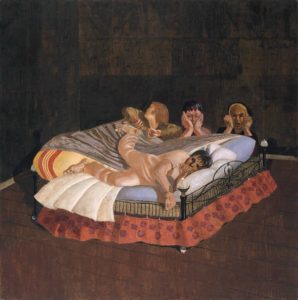This homily was delivered on 16 September 2013 based on Luke 7:1-10
 I made the mistake the other night of watching a horror film. It was “Insidious (Part 1). ” As I expected, after the movie, my imagination ran wild every time I found myself in a long corridor or dark corner. The movie is about the souls of the dead who are desperately waiting to occupy the bodies of the living, and in the movie, they’re depicted as wandering lost in this heaven-forsaken dimension which the psychic in the film mysteriously calls the “Further.”
I made the mistake the other night of watching a horror film. It was “Insidious (Part 1). ” As I expected, after the movie, my imagination ran wild every time I found myself in a long corridor or dark corner. The movie is about the souls of the dead who are desperately waiting to occupy the bodies of the living, and in the movie, they’re depicted as wandering lost in this heaven-forsaken dimension which the psychic in the film mysteriously calls the “Further.”
Anyway, to distract me and help me sleep that night, I picked up the book I’m currently reading—called Why is E = mc2? As you can guess, it’s about Albert Einstein’s theory of relativity. It explains how our intuitive notions of absolute space and time are actually not scientifically true, and we’re actually invited to replace these common-sense everyday concepts with the more scientifically accurate ones of relative space and time.
Now I mention all this because one way of reading our Gospel today is to consider it as a story about distances and space. Aside from Luke, the story of the healing of the Centurion’s Servant is found in two other Gospels: Matthew and interestingly enough, not Mark, but John. The versions in Matthew and Luke feature the well-known Mass response we say right before Communion, brought back recently by the New Missal: “Lord, I am not worthy that you should enter under my roof…”
This line is not found in John. Also, in John, the centurion is referred to as a Roman official, and it isn’t his servant who is ill, but his son. Moreover, in this version, it is not the official who suggests that the Lord perform His healing from a distance, but it is Jesus who sends him away assuring him of his son’s healing.
But in all three versions, our Lord Jesus never makes it to the official’s house; as the Centurion reminds the Lord in Matthew and Luke, He doesn’t need to! Like a leader who has numerous servants to do his bidding, the Lord can simply say the word, and the sick person will be healed. In other words, our Lord doesn’t have to show up to heal the servant, and that’s exactly what happens in all three versions. I think what this tells us is that distance does not prevent the Lord from helping us if we need it.
That’s consoling, I think, because as we know, it sometimes feels like the Lord is distant. He seems absent. His voice seems silent, and His face a distant blur. I think one truth being offered to us by this story is that the distance the Lord may seem to keep from us is never an obstacle to His work. That’s consoling.
What’s interesting though is that unlike the other two versions, in the version we read today from Luke, the Centurion doesn’t even show up before Jesus. Twice he sends envoys to Jesus: The first group to relay his request to Jesus and to introduce him and speak on his behalf; and the second group he sends to meet Jesus halfway on the road to say precisely that He need not go all the way to his home. He need only say the word and the servant shall be healed. For me, another truth that the story may be teaching us is that even the distance we ourselves keep from the Lord will not hinder Him from doing His work!
This sounds like a radical and subversive thought, doesn’t it? But I believe it is not un-theological. After all, St. Paul has written: Nothing can separate us from the love of Christ. And so, even in the moments when for whatever reason, we hide or run from Him, Christ our Lord remains accessible. For in His Incarnation, especially in His Passion and Death, our Lord Jesus has crossed every distance so that there’s no longer any human condition that is beyond His reach: not pain, not death, not even the experience of separation caused by sin. All this He has undergone so that now there’s no such thing as a God-forsaken place. Thanks to the love of Christ for us, no distance is too great, no darkness too deep.
So when we think about it, we could say that Einstein was right even when it comes to the spiritual life: for Christ, there’s no such thing as absolute space.
And also, when it comes to spirituality, the movie “Insidious” is wrong: There’s no such place as the Further.
Painting by Sir Stanley Spencer (1914)